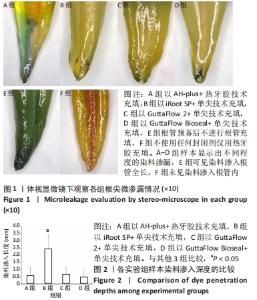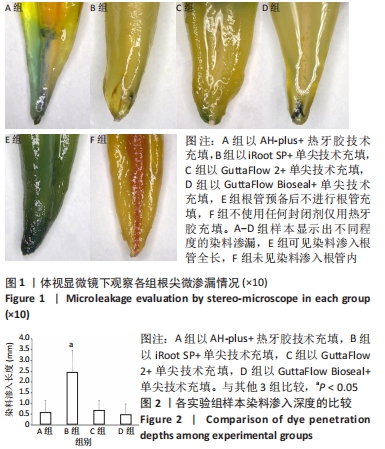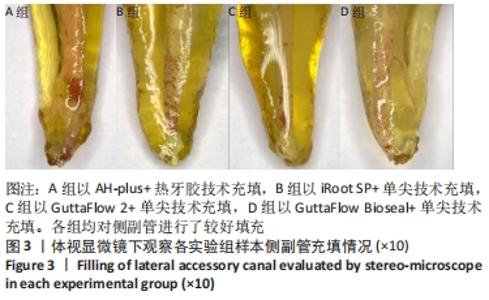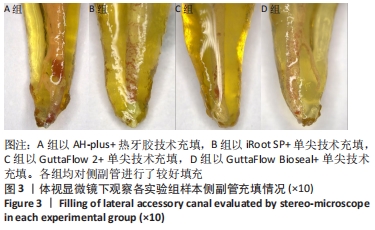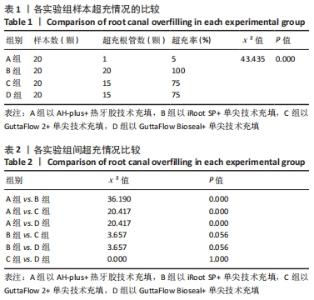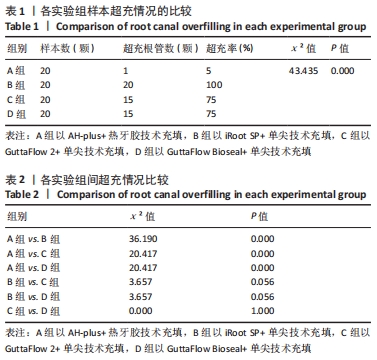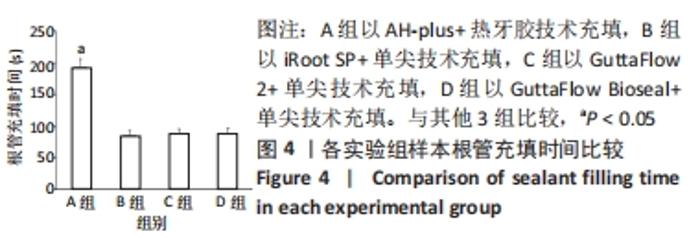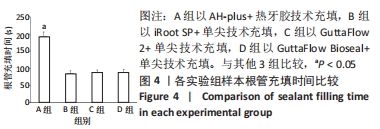Chinese Journal of Tissue Engineering Research ›› 2022, Vol. 26 ›› Issue (21): 3389-3393.doi: 10.12307/2022.649
Previous Articles Next Articles
Apical sealing of GuttaFlow Bioseal in oval-root canals
Shi Jinghua, Kang Wenyan, Man Dula, Liang Zhonghua, Wang Xiaoguang, Yin Yin, Zhang Lei
- Hohhot Stomatological Hospital, Hohhot 010030, Inner Mongolia Autonomous Region, China
-
Received:2021-08-30Accepted:2021-10-30Online:2022-07-28Published:2022-01-27 -
Contact:Zhang Lei, Chief physician, Hohhot Stomatological Hospital, Hohhot 010030, Inner Mongolia Autonomous Region, China -
About author:Shi Jinghua, Master, Attending physician, Hohhot Stomatological Hospital, Hohhot 010030, Inner Mongolia Autonomous Region, China -
Supported by:the Western Stomatology Clinical Research Fund of the Chinese Stomatological Association, No. CSA-W2019-03 (to ZL); Hohhot Science and Technology Plan Project, No. 2019-She-3-1 (to ZL)
CLC Number:
Cite this article
Shi Jinghua, Kang Wenyan, Man Dula, Liang Zhonghua, Wang Xiaoguang, Yin Yin, Zhang Lei. Apical sealing of GuttaFlow Bioseal in oval-root canals[J]. Chinese Journal of Tissue Engineering Research, 2022, 26(21): 3389-3393.
share this article
Add to citation manager EndNote|Reference Manager|ProCite|BibTeX|RefWorks
| [1] 张琛.根管充填的难点和误区[J].华西口腔医学杂志,2017,35(3):232-238. [2] WU MK, RORIS A, BARKIS D, et al. Prevalence and extent of long oval canals in the apical third. Oral Surg Oral Med Oral Pathol Oral Radiol Endod. 2000; 89(6):739-743. [3] MAUGER MJ, SCHINDLER WG, WALKER WA 3RD. An evaluation of canal morphology at different levels of root resection in mandibular incisors. J Endod. 1998;24(9):607-609. [4] TANOMARU-FILHO M, TORRES FFE, CHÁVEZ-ANDRADE GM, et al. Physicochemical Properties and Volumetric Change of Silicone/Bioactive Glass and Calcium Silicate-based Endodontic Sealers. J Endod. 2017;43(12): 2097-2101. [5] COLLADO-GONZÁLEZ M, TOMÁS-CATALÁ CJ, OÑATE-SÁNCHEZ RE, et al. Cytotoxicity of GuttaFlow Bioseal, GuttaFlow2, MTA Fillapex, and AH Plus on Human Periodontal Ligament Stem Cells. J Endod. 2017;43(5):816-822. [6] GANDOLFI MG, SIBONI F, PRATI C. Properties of a novel polysiloxane-guttapercha calcium silicate-bioglass-containing root canal sealer. Dent Mater. 2016;32(5):e113-126. [7] SAYGILI G, SAYGILI S, TUGLU I, et al. In Vitro Cytotoxicity of GuttaFlow Bioseal, GuttaFlow 2, AH-Plus and MTA Fillapex. Iran Endod J. 2017;12(3):354-359. [8] AKCAY M, ARSLAN H, DURMUS N, et al. Dentinal tubule penetration of AH Plus, iRoot SP, MTA fillapex, and guttaflow bioseal root canal sealers after different final irrigation procedures: A confocal microscopic study. Lasers Surg Med. 2016;48(1):70-76. [9] RODRÍGUEZ-LOZANO FJ, COLLADO-GONZÁLEZ M, TOMÁS-CATALÁ CJ, et al. GuttaFlow Bioseal promotes spontaneous differentiation of human periodontal ligament stem cells into cementoblast-like cells. Dent Mater. 2019;35(1):114-124. [10] FLEMING CH, LITAKER MS, ALLEY LW, et al. Comparison of classic endodontic techniques versus contemporary techniques on endodontic treatment success. J Endod. 2010; 36(3): 414-418. [11] GANI O, VISVISIAN C. Apical canal diameter in the first upper molar at various ages. J Endod. 1999;25(10):689-691. [12] 姚娜,马琦,尹星喆,等.4种充填方法对椭圆形根管充填效果的体外研究[J].实用口腔医学杂志,2008(6):874-878. [13] 黎景景,陈苏蕾,李俊亮,等.4种充填方法对椭圆形根管根尖超填及封闭性能的影响[J].口腔医学研究,2017,33(10):1036-1039. [14] LEE SH, OH S, AL-GHAMDI AS, et al. Sealing ability of AH Plus and GuttaFlow Bioseal. Bioinorg Chem Appl. 2020;2020:8892561. [15] DELFINO MM, GUERREIRO-TANOMARU JM, TANOMARU-FILHO M, et al. Immunoinflammatory response and bioactive potential of GuttaFlow bioseal and MTA Fillapex in the rat subcutaneous tissuel. Sci Rep. 2020;10(1):7173. [16] PEDULLÀ E, ABIAD RS, CONTE G, et al. Neelakantan P. Root fillings with a matched-taper single cone and two calcium silicate-based sealers: an analysis of voids using micro-computed tomography. Clin Oral Investig. 2020;24(12):4487-4492. [17] HOIKKALA NJ, WANG X, HUPA L, et al. Dissolution and mineralization characterization of bioactive glass ceramic containing endodontic sealer Guttaflow Bioseal. Dent Mater J. 2018;37(6):988-994. [18] ZHONG X, SHEN Y, MA J, et al. Quality of Root Filling after Obturation with Gutta-percha and 3 Different Sealers of Minimally Instrumented Root canals of the Maxillary First Molar. J Endod. 2019;45(8):1030-1035. [19] CAMARGO RV, SILVA-SOUSA YTC, ROSA RPFD, et al. Evaluation of the physicochemical properties of silicone- and epoxy resin-based root canal sealers. Braz Oral Res. 2017;31:e72. [20] FLORES DS, RACHED FJ JR, VERSIANI MA, et al. Evaluation of physicochemical properties of four root canal sealers. Int Endod J. 2011;44(2):126-135. [21] ALBINO SOUZA M, DALLA LANA D, GABRIELLI E, et al. Effectiveness of final decontamination protocols against Enterococcus faecalis and its influence on bond strength of filling material to root canal dentin. Photodiagnosis Photodyn Ther. 2017;17:92-97. [22] BODRUMLU E, PARLAK E, BODRUMLU EH. The effect of irrigation solutions on the apical sealing ability in different root canal sealers. Braz Oral Res. 2010;24(2):165-169. [23] BORGES RP, SOUSA-NETO MD, VERSIANI MA, et al. Changes in the surface of four calcium silicate-containing endodontic materials and an epoxy resin-based sealer after a solubility test. Int Endod J. 2012;45(5):419-428. [24] DE-DEUS G, BELLADONNA FG, SILVA EJNL, et al. Micro-CT assessment of dentinal micro-cracks after root canal filling procedures. Int Endod J. 2017; 50(9):895-901. [25] KAŞıKÇı BILGI I, KÖSELER I, GÜNERI P, et al. Efficiency and apical extrusion of debris: a comparative ex vivo study of four retreatment techniques in severely curved root canals. Int Endod J. 2017;50(9):910-918. [26] 彭俐,王祖华.iRoot SP的理化性质和生物学性能[J].国际口腔医学杂志, 2018,45(1):78-84. [27] VIAPIANA R, FLUMIGNAN DL, GUERREIRO-TANOMARU JM, et al. Physicochemical and mechanical properties of zirconium oxide and niobium oxide modified Portland cement-based experimental endodontic sealers. Int Endod J. 2014;47(5):437-448. [28] ZHOU HM, SHEN Y, ZHENG W, et al. Physical properties of 5 root canal sealers. J Endod. 2013;39(10):1281-1286. [29] SCHILDER H. Filling root canals in three dimensions. 1967. J Endod. 2006; 32(4):281-290. [30] 黄晓想,付梅,阎国强,等.根管治疗失败患牙根尖区侧支根管检出率和充填情况的研究[J].中华口腔医学杂志,2018,53(4):243-247. [31] MOZAYENI MA, ASNAASHARI M, MODARESI SJ. Clinical and Radiographic Evaluation of Procedural Accidents and Errors during Root Canal Therapy. Iran Endod J. 2006;1(3):97-100. [32] YAMAGUCHI K, MATSUNAGA T, HAYASHI Y. Gross extrusion of endodontic obturation materials into the maxillary sinus: a case report. Oral Surg Oral Med Oral Pathol Oral Radiol Endod. 2007;104(1):131-134. [33] ROSEN E, GOLDBERGER T, TASCHIERI S, et al. The Prognosis of Altered Sensation after Extrusion of Root Canal Filling Materials: A Systematic Review of the Literature. J Endod. 2016;42(6):873-879. [34] BLANAS N, KIENLE F, SÁNDOR GK. Inferior alveolar nerve injury caused by thermoplastic gutta-percha overextension. J Can Dent Assoc. 2004;70(6):384-387. [35] SCOTTI R, TIOZZO R, PARISI C, et al. Biocompatibility of various root canal filling materials ex vivo. Int Endod J. 2008;41(8):651-657. [36] NINO-BARRERA JL, GAMBOA-MARTINEZ LF, LASERNA-ZULUAGA H, et al. Factors associated to apical overfilling after a thermoplastic obturation technique - Calamus® or Guttacore®: a randomized clinical experiment. Acta Odontol Latinoam. 2018;31(1):45-52. [37] FANG Y, WANG X, ZHU J, et al. Influence of Apical Diameter on the Outcome of Regenerative Endodontic Treatment in Teeth with Pulp Necrosis: A Review. J Endod. 2018;44(3):414-431. [38] CANDEIRO GTM, MOURA-NETTO C, D’ALMEIDA-COUTO RS, et al. Cytotoxicity, genotoxicity and antibacterial effectiveness of a bioceramic endodontic sealer. Int Endod J. 2016;49(9):858-864. [39] CHANG SW, LEE SY, KANG SK, et al. In vitro biocompatibility, inflammatory response, and osteogenic potential of 4 root canal sealers: Sealapex, Sankin apatite root sealer, MTA Fillapex, and iRoot SP root canal sealer. J Endod. 2014;40(10):1642-1648. [40] 李成龙,吴也可,李铀,等.GuttaFlow2常温流动牙胶在磨牙急性牙髓炎一次性根管治疗的应用[J].重庆医科大学学报,2018,43(9):1233-1236. |
| [1] | Yao Xiaoling, Peng Jiancheng, Xu Yuerong, Yang Zhidong, Zhang Shuncong. Variable-angle zero-notch anterior interbody fusion system in the treatment of cervical spondylotic myelopathy: 30-month follow-up [J]. Chinese Journal of Tissue Engineering Research, 2022, 26(9): 1377-1382. |
| [2] | Zhang Jinglin, Leng Min, Zhu Boheng, Wang Hong. Mechanism and application of stem cell-derived exosomes in promoting diabetic wound healing [J]. Chinese Journal of Tissue Engineering Research, 2022, 26(7): 1113-1118. |
| [3] | An Weizheng, He Xiao, Ren Shuai, Liu Jianyu. Potential of muscle-derived stem cells in peripheral nerve regeneration [J]. Chinese Journal of Tissue Engineering Research, 2022, 26(7): 1130-1136. |
| [4] | Zhang Tong, Cai Jinchi, Yuan Zhifa, Zhao Haiyan, Han Xingwen, Wang Wenji. Hyaluronic acid-based composite hydrogel in cartilage injury caused by osteoarthritis: application and mechanism [J]. Chinese Journal of Tissue Engineering Research, 2022, 26(4): 617-625. |
| [5] | Li Hui, Chen Lianglong. Application and characteristics of bone graft materials in the treatment of spinal tuberculosis [J]. Chinese Journal of Tissue Engineering Research, 2022, 26(4): 626-630. |
| [6] | Gao Cangjian, Yang Zhen, Liu Shuyun, Li Hao, Fu Liwei, Zhao Tianyuan, Chen Wei, Liao Zhiyao, Li Pinxue, Sui Xiang, Guo Quanyi. Electrospinning for rotator cuff repair [J]. Chinese Journal of Tissue Engineering Research, 2022, 26(4): 637-642. |
| [7] | He Yunying, Li Lingjie, Zhang Shuqi, Li Yuzhou, Yang Sheng, Ji Ping. Method of constructing cell spheroids based on agarose and polyacrylic molds [J]. Chinese Journal of Tissue Engineering Research, 2022, 26(4): 553-559. |
| [8] | He Guanyu, Xu Baoshan, Du Lilong, Zhang Tongxing, Huo Zhenxin, Shen Li. Biomimetic orientated microchannel annulus fibrosus scaffold constructed by silk fibroin [J]. Chinese Journal of Tissue Engineering Research, 2022, 26(4): 560-566. |
| [9] | Chen Xiaoxu, Luo Yaxin, Bi Haoran, Yang Kun. Preparation and application of acellular scaffold in tissue engineering and regenerative medicine [J]. Chinese Journal of Tissue Engineering Research, 2022, 26(4): 591-596. |
| [10] | Kang Kunlong, Wang Xintao. Research hotspot of biological scaffold materials promoting osteogenic differentiation of bone marrow mesenchymal stem cells [J]. Chinese Journal of Tissue Engineering Research, 2022, 26(4): 597-603. |
| [11] | Shen Jiahua, Fu Yong. Application of graphene-based nanomaterials in stem cells [J]. Chinese Journal of Tissue Engineering Research, 2022, 26(4): 604-609. |
| [12] | Guan Jian, Jia Yanfei, Zhang Baoxin , Zhao Guozhong. Application of 4D bioprinting in tissue engineering [J]. Chinese Journal of Tissue Engineering Research, 2022, 26(3): 446-455. |
| [13] | Zeng Yuwei, Huang Chuang, Wei Jianguo, Duan Dongming, Wang Le. Tracing transplanted bone marrow mesenchymal stem cells in rat calvarial defect by bioluminescence imaging [J]. Chinese Journal of Tissue Engineering Research, 2022, 26(25): 3968-3973. |
| [14] | He Qi, Xu Faya, Li Xiyan, Han Lei, Xiao Yanbing, Tu Jiao. Preparation and sterilization method of human acellular amniotic membrane scaffold [J]. Chinese Journal of Tissue Engineering Research, 2022, 26(25): 4028-4033. |
| [15] | Wang Kang, Zhi Xiaodong, Wang Wei. Effect and mechanism of human amniotic epithelial cells on nerve injury repair [J]. Chinese Journal of Tissue Engineering Research, 2022, 26(25): 4046-4051. |
| Viewed | ||||||
|
Full text |
|
|||||
|
Abstract |
|
|||||
